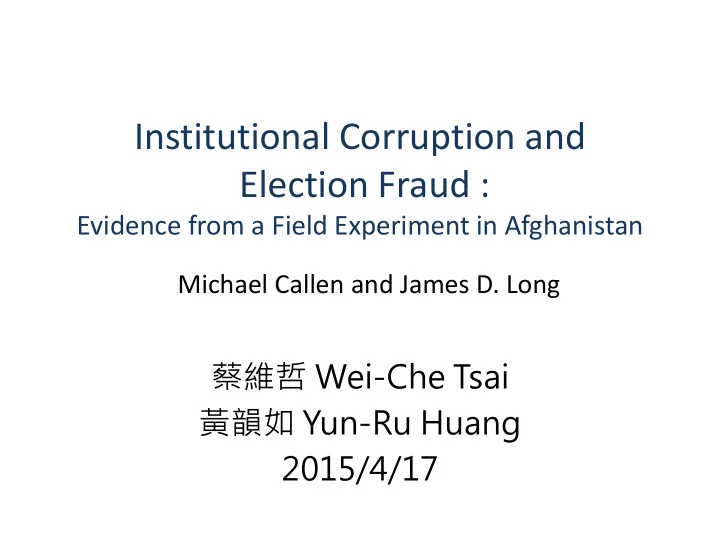

Institutional Corruption and Election Fraud : Evidence from a Field Experiment in Afghanistan Michael Callen and James D. Long 蔡維哲 Wei-Che Tsai 黃韻如 Yun-Ru Huang 2015/4/17
Outline • Introduction and argument • Political background of Afghanistan • Field Experiment Design • Data and Results • Conclusion • Comment
Introduction
Introduction • Election manipulation of young democracy • How to measure it?
Introduction • Election manipulation of young democracy Aggregation fraud: before
Introduction • Election manipulation of young democracy Aggregation fraud: after before
• Before the election • A letter would be sent to some of the polling station treatment group Letter treatment
• Right after the election • Take photos in every polling station • Only some of them were warned with the letter
Arguments The effect of letter treatment: • Does the announcement reduce election fraud? • How do the connected candidates perform under the monitoring effect?
• Votes aggregation differences were found in 78% of the polling stations
• Votes aggregation differences were found in 78% of the polling stations • Connected candidates were in charge of 3.5 fraudulent votes in each substation
Political Background
Post-Invasion Democracy in Afghanistan • 2001: the 911 Day • 2004: Hamid Karzai was elected as the President of Afghanistan • 2009: Karzai won his second presidency. • 2010: lower house of parliament election
Electoral Institutions SNTV • Single-nontransferable vote(SNTV) • each voter casts one vote for one candidate in a multi-candidate race for multiple offices. Who gets the most votes wins. Candidate Votes There are 3 seats to be filled and 5 A 819 Candidates : A, B, C, D and E. B 1,804 C, D and E are the winning candidates. C 1,996 D 1,999 E 2,718
Electoral Institutions • SNTV makes incentive to fraud – thin victory margins make fraudulent votes highly valuable – More candidates means more potential manipulation • Weak electoral institution • The state does not have complete control territory – Most candidates are warlords – Informal social network
Vote Aggregation Procedure • Result forms is recorded in each substation Polling • Result forms are posted for public viewing Center • Copies of the result forms are sealed and sent to Provincial aggregation center PAC • All result forms are sent to national aggregation center in Kabul, the capital of Afghanistan NAC
Measuring Fraud Photo shot on NAC website Photo Shot Outside Polling Center
Pattern of Fraud
Political Connections and Aggregation Fraud • 𝑍 𝑗𝑘𝑡 = 𝛾 0 + 𝛾 1 𝐽𝑜𝑤𝑓𝑡𝑢𝑗𝑏𝑢𝑓𝑒 𝑗 + 𝛾 2 𝐷𝑝𝑜𝑜𝑓𝑑𝑢𝑗𝑝𝑜 𝑗 + 𝛿 𝑘 + 𝜁 𝑗𝑡 • 𝑍 𝑗𝑘𝑡 : votes number difference between prior and post aggregation • 𝐽𝑜𝑤𝑓𝑡𝑢𝑗𝑏𝑢𝑓𝑒 𝑗 is dummy variable =1 if candidate have political history data which is investigated by local consulting firm (n=57) • 𝐷𝑝𝑜𝑜𝑓𝑑𝑢𝑗𝑝𝑜 𝑗 : is dummy variable=1 if candidate have connection to President Karzai or to district and provincial aggregators • 𝛿 𝑘 : constituency j • 𝜁 𝑗𝑡 : candidate i and polling substation s
Political Connections and Aggregation Fraud
Political Connections and Aggregation Fraud • Omitted variable problem • Only data on connections for the most powerful candidates (n=57) • Omitted outlier
Experiment
Experiment design • A baseline survey for the treatment and control group • Race, plans to turnout during election, believe vote is secret… etc are all not significance, so we could consider two group basically are homogeneous
Experimental Intervention • 471 polling center(7.8 % of polling center) for safety concern • 238 treat group and 233 control group • Treatment effect: if the Polling center manager received a letter
• Delivery: 10 AM - 4 PM in 238 group • Managers are asked to sign; 17 refuse to sign • Take a picture of the Election Return Form in 471 polling center
Experimental Intervention • The key of experimental protocol – Notify manager on election day to ensure they are aware of treatment – Only research team know the experiment sample, no election officials had means to determine which sites to be control
Data and Results
Data and Results
A. Aggregation Fraud • Absolute value of votes differences (fraudulent votes) 17.170 for the control samples 5.484 for the treatment group
A. Aggregation Fraud • Absolute value of votes differences (fraudulent votes) 17.170 for the control samples 5.484 for the treatment group • Treatment < Control letter warning works
A. Aggregation Fraud • Absolute value of votes differences (fraudulent votes) 20.1% decrease for connected candidates 30.0% decrease for highly connected candidates
A. Aggregation Fraud • Absolute value of votes differences (fraudulent votes) 20.1% decrease for connected candidates 30.0% decrease for highly connected candidates Elite candidates: votes reduced by 25%
B. Theft and Damaging of forms • Missing voting sheets • Candidate agents stole or damage materials at 13.16% (62 out of 471 stations)
B. Theft and Damaging of forms • control: 18.9% letter treatment: 8.1% (10.8% lower)
C. Tests for Spatial Externalities • Chilling effect? • Having a treated neighbor in 2 km? NO : 42.8 (votes) YES : 17.8 (votes) • high elasticity of fraud
votes difference < 1km : - 6.742 1~2km: - 4.738
votes difference < 1km : - 6.742 The closer to treatment, the 1~2km: - 4.738 lower number of votes
Conclusion Negative effects on politics: • Entry barriers for unconnected candidates • Incentive to cultivate connections • Could not show the real preference of voters
• letter treatment had negative effect on – number of votes of connected candidates – election fraud – theft of election forms
Comment • Is the letter threatening? If so, why kept on manipulating the election? The Boy Who Cried Wolf? • Wouldn’t it be selection biased to collect data from relatively peaceful areas?
Recommend
More recommend